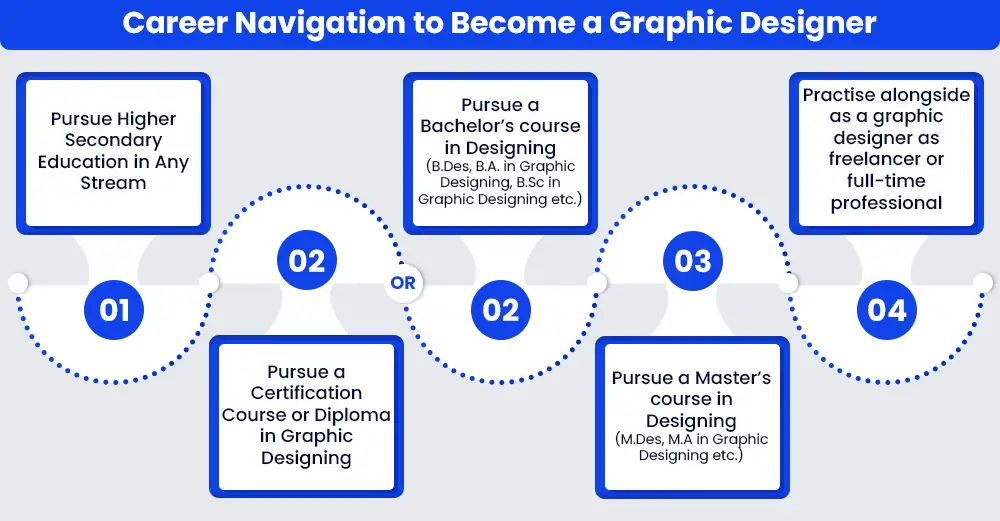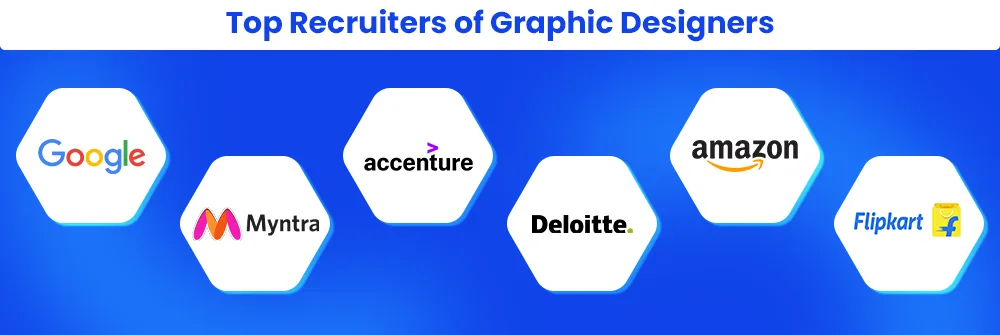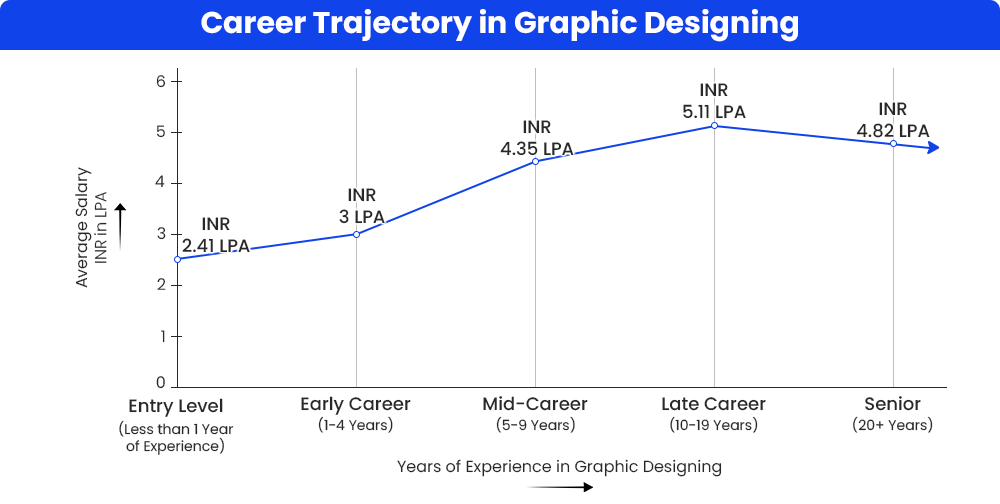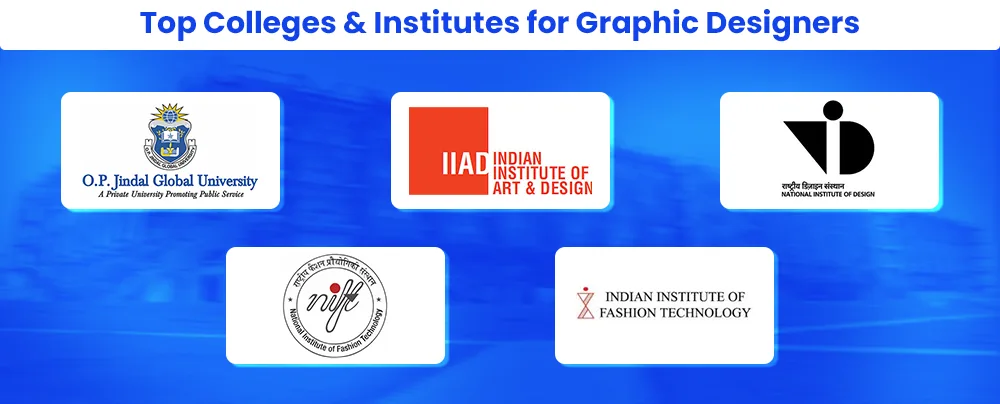Expert Interviews
- University Reviews
- Career Guide
 Video Counseling
Video CounselingImportant Facts
- Ask any Question - CV Forum

How To Become a Graphic Designer In 2025: A Complete Career Guide
College Vidya Team Apr 11, 2025 1.1K Reads

If you are someone who has been keen about art and amazed by fascinating visuals seen on your screen, you might have wondered about the artistic geniuses that put their minds into creating those visuals. If you are someone who wishes to integrate your artistic skills with technological prowess to create visual designs, then graphic designing might be your calling!Graphic designing (often called “graphical designing”) is a career pathway in the technological fields that pertains to the creation of digital visuals by using various designing softwares.
Graphic designing entails the combination of creative ideas with knowledge of using designing softwares to generate impactful visual pieces such as logos, 2D infographics, animations, banners, posters and so on. So, to venture into this career field, you need to have strong skills of creativity, innovation and unique perspectives to depict your artistic ideas.
Why Choose a Career in Graphic Designing?
Seeking a career in graphic design is not only lucrative from a financial perspective, but also involves a meaningful way of channeling your inner artistic prowess. Given the pace at which visual representation and communication is turning into a norm, the demand for graphic designers is on an exponential rise.
Virtually all corporations and organisations now require creative and efficient graphic designers to design visual content for their business operations, be it for marketing, internal communications or logo designing.
Here are some key statistics and reasons to consider when going for a career in graphic designing:
- Estimated Growth in Industrial Demand: Current growth rates of the graphic designing industry indicate that it is likely to experience an enhanced demand of about 3% by 2030. Further, the observed growth of this industry has been found to be higher than the overall economy.
- Job Security in the Digital World: Given the rapid digitisation of earlier undigitised spaces, graphic designing is a form of art that is here to stay. Venturing into the field early on to set pace to your career can ensure future stability and greater demand of your skills repertoire.
- Flexibility in Channels of Income: A major benefit of becoming a graphic designer is that it allows flexible channels of income. Graphic designers in the contemporary industries are working not only full-time but also part-time and on a freelancing basis depending on their convenience. Figures indicate, that in turn, about 36% of all graphic designers are freelancer.
- Integration of Artistic Skills with Stable Income: For those interested in artistic ventures but worried about finding a stable source of income, graphic designing can be a lucrative career domain. Not only does it allow for you to channel your creative skills into impactful pieces, it also ensures that you continue to grow financially in your career alongside.
- Early Training & Income: If you want to start off early in becoming financially self-dependent, then graphic designing can be a go-to career option for you. As soon as you develop sufficient skills of graphic designing, you can work on enhancing your portfolio and signing for freelancing projects, which allows for considerable exposure and financial independence from early on.
Roles & Responsibilities of a Graphic Designer
Before deciding graphic designing as a career pathway for yourself, it is important to have an understanding of the nature of the job itself. Graphic designing in its job components and responsibilities is quite diverse, and hence provides the professional with myriad of opportunities to put their artistic skills to use.
Some of the key job responsibilities and tasks associated with graphic designing include:
- Understanding the client requirement and vision for a product/service.
- Communicate own ideas or brainstorm options about visualisation of the product to the client.
- Brainstorm how the first draft of the product looks, including understanding the layout design.
- Start preparing rough ideas and layouts of the product in the form of sketches or digital pieces.
- Research about the effective portrayal of digital designs and visual presentations.
- Regularly seek client’s feedback and approvals on layouts and design progress.
- Create visually impactful designs, logos, pieces etc. using computer softwares based on client inputs.
- Use computer softwares for designing to finalise the pieces further based on client inputs.
- Create archives of digital art, infographics, logos etc. worked upon, preferably on a project-wise basis.
- Work on creating a personal portfolio of one’s own work which is impactful and communicates the vision for digital designing effectively to others.
- Research and upskill oneself regularly with respect to new softwares and tools for graphic designing.
Given these job responsibilities that a graphic designer must possess, it becomes imperative to possess certain key skills to succeed in this domain.
Key Skills Needed for Graphic Designing
As a career domain, graphic designing requires certain key skills, including soft skills and technical skills in terms of working knowledge of designing softwares.
Some of the main soft skills needed to succeed as a graphic designer include:
- Creative Visualisation: This is by far the foremost critical soft skill for a graphic designer. In addition to generating creative ideas, it is also essential for them to be able to represent the ideas effectively through visuals, hence making creative visualization a critical skill in this career path.
- Planning: Planning one’s timelines to work on projects, designing layouts of visual pieces, working on multiple projects simultaneously etc. all require a prowess in effective planning by a graphic designer.
- Time Management & Agility: Given the fast-paced nature of this career pathway, effective time management and agility are very important to thrive as graphic designers. Clients often require the designer to handle multiple projects simultaneously without compromising the quality of the product. Additionally, incorporating multiple inputs and suggested changes from clients also requires sufficient adaptability and agility in the approach a graphic designer.
- Attention to Detail: Being an artistic career domain, attention to detail is important for a graphic designer to ensure that their work is sufficiently polished, free of errors and consistent throughout the project.
- Knowledge of User Psyche: In addition to mastering one’s creative skills, having an idea of the user’s or viewer’s psyche is important for a graphic designer to come up with work that is truly impactful. Hence, understanding the viewer’s psyche, demands and expectations etc. are important for a graphic designer.
Since graphic designers have to work with various tools and softwares to create digital visuals, they also need to gain technical mastery of certain crucial designing tools. A few of those tools have been elaborated upon below:
|
Software |
Key Features/Uses |
|
Adobe Illustrator |
A graphic design tool used for creation of scalable projects including logos, illustrations, vectors, website content etc. |
|
Adobe Photoshop |
An advanced photo-editing and designing tool used for layer-by-layer editing, photograph editing and retouching, digital art creation and graphic designing |
|
Adobe InDesign |
A graphic designing tool used specifically for creation of brochures, magazine pages, logos, digital publishing and print-ready digital content |
|
Adobe Dreamweaver |
A web development tool part of the Adobe Cloud Suite that is used for web graphic development in addition to coding, web page development etc. |
|
Cascading Style Sheet 3 (CSS 3) |
A programming language used to develop and format the layout of HTML pages and web pages, create animations etc. |
|
Procreate |
An illustration and graphic designing application available on Apple devices, used for making visual designs, digital illustrations, animations and so on. |
What are the Career Opportunities for Graphical Designing (Types of Options available in graphic designing)
Graphic designing in itself is an umbrella term for a number of specifically available roles in the field which allow the professional to explore specific domains in the field. This is one of the key advantages of graphic designing as a career pathway–it offers diverse options for the person to explore or specialise in.
What’s more, having multiple skills further enhances your portfolio, allowing for more lucrative options and opportunities!
Mentioned below are some of the major domains and roles that a graphic designer can work in:
|
Career Option |
Description |
Average Salary (Per Annum) |
|
Logo Designer |
Responsible for clearly gauging client requirements and vision to integrate them with artistic aesthetics to create final versions of logos for companies and individuals |
INR 5.5 LPA |
|
Graphic Designer |
Responsible for using artistic ideas and create digital visuals in various forms such as logos, vectors, animations etc. |
INR 3.13 LPA |
|
2D Animator |
Responsible for creating 2-dimensional sequential illustrations that create the illusion of movement when integrated together |
INR 2.4 LPA |
|
UX Designer |
Responsible for the development of user interfaces including webpages, visual content etc. for enhancing the user experience |
INR 6.15 LPA |
|
UI Designer |
Responsible for managing the visual aspects of any platform’s user interface such as websites, web pages, applications etc. |
INR 6.6 LPA |
|
Web Designer |
Responsible for managing all aspects of webpages and websites including the visual design, layout, formatting etc. |
INR 3.3 LPA |
|
Advertising Designer |
Responsible for working on the designing of digital content for advertising products or services effectively. |
INR 3.8 LPA |
Career Analysis: What is the Salary & Demand for Graphic Designing?
The nature of the career of graphic designing can be viewed from three lenses–the industry trends in the filed, the course fee and costs involved in becoming a graphic designer and lastly the career growth trajectory of this field. These components have been delved into below.
Demand for Graphic Designers: Industry Trends
- The field of graphic designing is not just rapidly expanding, but is also one that is here to stay in terms of stability in industry trends.
- For instance, a report by IBISWorld indicated that the global graphic designing industry stood at a revenue generation of $45 billion worldwide in 2023.
- This figure, in addition to figures indicating higher growth rate of the industry globally than the overall economy (source: U.S. Book of Labour Law) point to the high potential and industry demand for graphic designers.
- Given the rapid digitisation of marketspaces and business ventures, digital media has become a major channel of marketing. Given this context, the demand for graphic designers is on an exponential rise.
Fees & Cost Involved in Becoming a Graphic Designer
Given the multiple pathways to become a graphic designer, one can take up courses of various levels to upskill in softwares for graphic designing. For instance, the time as well as financial investments one makes in becoming a graphic designer would vary depending upon whether they pursue a degree course, a short-term diploma or a certification. Overall, the fee for graphic designing courses is on a relatively lower end of the spectrum.
These courses are available to be pursued majorly in the online mode. Further, various learning resources for mastering softwares including the Adobe Cloud suite are also available online free of cost for graphic designers to learn from. Hence, the costs involved in graphic designing are relatively lower.
Career Growth Trajectory of Graphic Designer
While the initial salary range of a graphic designer may start in the low-moderate range (between INR 2 LPA to INR 3 LPA), one can see considerable growth in their compensation through the course of their career. Furthermore, freelance work in graphic designing provides a potent channel for enhancing one’s earnings alongside a full-time role. The timeline and potential salaries through the years for a graphic designer have been outlined below based on latest statistics and figures.

While graphical designers can find employability in a large number of industries with digital transformation becoming rampant, the top recruiters of graphic designers include e-commerce platforms, search engine giants and so on, as enlisted below:

Career Navigator: What Course to Pursue for a Career in Graphic Designing? (courses, colleges, options in India and abroad + how to find opportunities in this field)
The options available to choose for becoming a graphic designer are varied and diverse. There is no exclusive career pathway you require to practise as a professional graphic designer. The dynamicity and agility of the field places significant value on freelancers as well as amateur graphic designers.
In addition to self-learning through resource materials available on the internet, a systematic approach to upskilling and gaining certain qualifications in the field can help enhance the available career options in this field. The overall career trajectory for the same is elaborated below.

Some of the popular degree courses one can seek in this field include:
|
Course |
Average Fee |
Course Duration |
|
INR 6,50,000 |
2 Years |
|
|
Bachelors of Design (B.Des) in Graphic Designing |
INR 4,00,000 |
4 Years |
|
Bachelor of Arts (B.A) in Graphic Designing |
INR 2,50,000 |
4 Years |
|
B.Sc in Graphic Design |
INR 3,00,000 |
3 Years |
Additionally, some of the popular diploma and certification courses in graphic designing include:
|
Course |
Average Fee |
Course Duration |
|
Certificate Course in Graphic Design |
INR INR 60,000 |
3-6 Months |
|
Advanced Diploma in Graphic Design |
INR 2,00,000 |
2 Years |
|
Certificate Course in Graphic Design |
INR 30,000 |
6 Months |
|
Post Graduate Diploma in Graphic Design |
INR 1,50,000 |
3 Months |
|
Professional Certificate in Graphic Design |
INR 80,000 |
1 Year |
A few of the prominent public and private colleges in India for pursuing formal education in graphic design include

Conclusion
As this blog explains, graphic designing is a creative field that includes a fusion of technical expertise and artistic prowess- the perfect blend for those aspirants interested to pursue a career in digital art. With career options in a number of prospective and well-paid domains like animation, web designing, UI/UX designing etc. this field is one of the popularly pursued technical domains. The ease of entry into this industry further makes it an appealing option to consider for many.
FAQs (Frequently Asked Questions)
To become a graphic designer, you must start developing proficiency in popular graphic designing applications and softwares such as Illustrator, Photoshop, Procreate etc. and upskill yourself regularly in the use of their features. Gradually, you can start curating your portfolio of artworks and pieces and explore professional options on part-time, full-time or freelancing basis. Alternatively, you can pursue formal training in graphic designing through courses like B.Des, M.Des, B.A. in Graphic Designing, PG diplomas and certifications in designing etc.
- Which college is best for graphic designing?
Some of the well-regarded institutions offering courses in graphic designing include IIAD, NID, NIFT, O. P. Jindal Global University etc.
Some of the well-regarded institutions offering courses in graphic designing include IIAD, NID, NIFT, O. P. Jindal Global University etc.
Yes, the field of graphic designing does not offer any educational restrictions to aspirants wishing to venture into the field. Even if you are from a humanities background, you can train and upskill yourself in various designing softwares and put your skills to use to freelance or pursue opportunities in graphic designing roles.
On an average, a graphic designer can earn anywhere between INR 3 LPA to INR 5 LPA in the initial years of starting their career. This figure can further grow through freelancing and/or growing years of experience.
Some of the commonly pursued courses to become a graphic designer include a Bachelor of Design (B.Des), a Masters of Design (M.Des), a B.A. in Graphic Designing, a B.Sc in Graphic Designing etc. A number of certifications and diplomas are also offered in the specialisation of graphic designing.

Idea Alchemist / Concept Creator / Insight Generator
We are an online education platform where users can compare 100+ online universities on 30+ X-factors in just 2 minutes. With an active CV community, we have transformed online learning to quite an extent. With the CV Subsidy scheme, we contributing to GER in India while helping our learners with their finances in their “Chuno Apna Sahi” journey!
Every query is essential.
Our team of experts, or experienced individuals, will answer it within 24 hours.
Recommended for you
Tired of dealing with call centers!
Get a professional advisor for Career!
LIFETIME FREE
Rs.1499(Exclusive offer for today)

Pooja
MBA 7 yrs exp

Sarthak
M.Com 4 yrs exp

Kapil Gupta
MCA 5 yrs exp
or



Career Finder
(Career Suitability Test)
Explore and Find out your Most Suitable Career Path. Get Started with our Career Finder Tool Now!
ROI Calculator
Find out the expected salary, costs, and ROI of your chosen online university with our free calculator.
